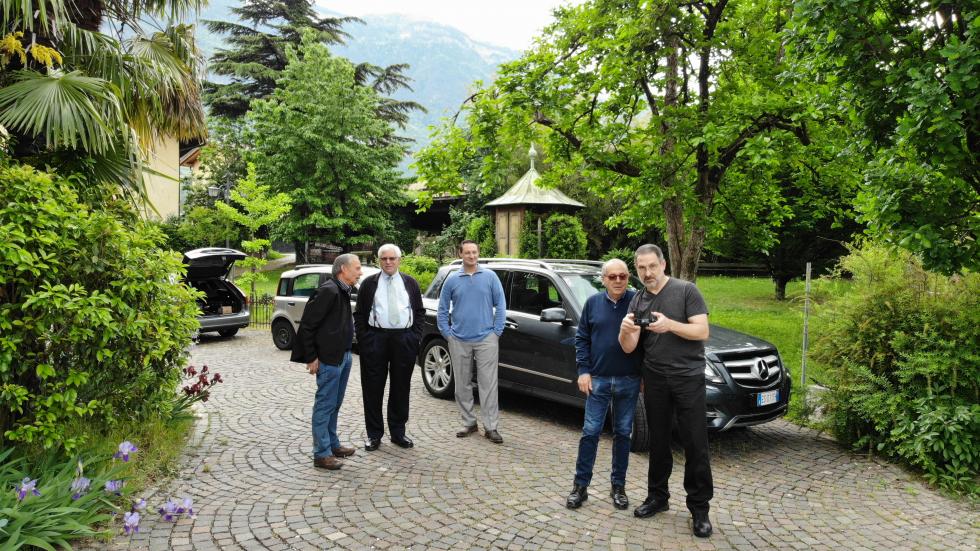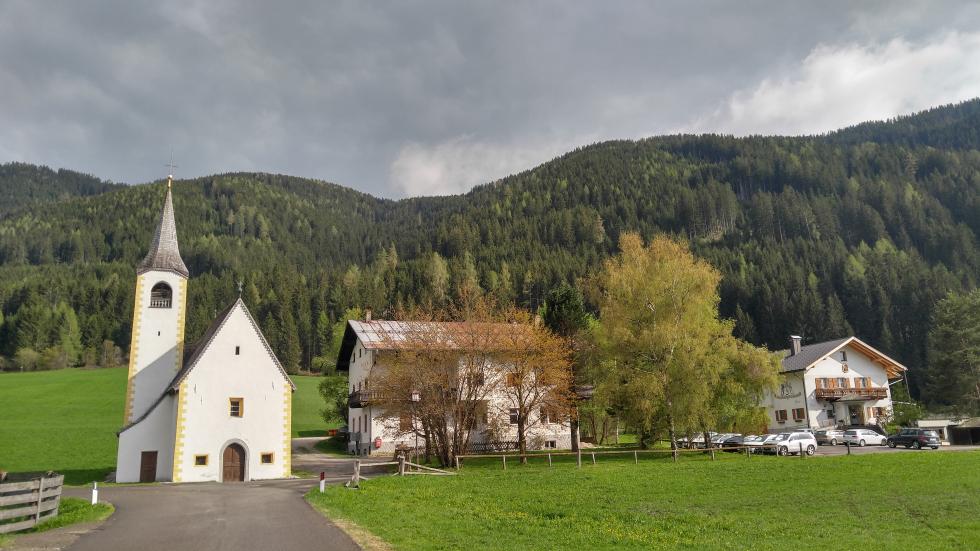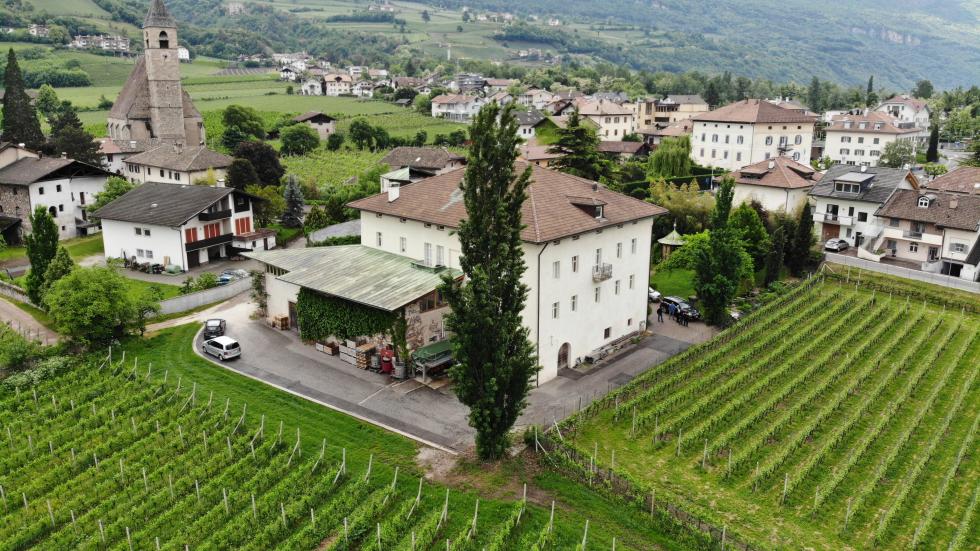The ever-bustling Rick Mindermann assumes myriad roles as the store director of Corti Brothers, the old-fashioned specialty grocery store in East Sacramento known for its eclectic array of high-quality products from around the world.
One of his major duties is raising and curating the store’s profile in the digital world, which has not been an easy task, given his boss and store owner Darrell Corti has a history of resisting change. “I’m sort of catatonic in the modern world,” Corti says. “I know absolutely nothing about it.”
In northern Italy, Rick Mindermann shows off the drone he brought
along to shoot videos and photos of Darrell Corti. (Photos
courtesy Rick Mindermann)

In 1995, Mindermann became Darrell’s personal assistant. And two years later, in 1997, Mindermann was charged with establishing and overseeing the store’s IT program, “a head-first immersion for me,” he says. “I had some experience and was always a proponent. The technology keeps growing, and what we eat and drink keep growing, too. We have to keep up.”
One major part of Corti Brothers’ technological advancements was transforming Darrell Corti’s trademark newsletter — which he has written with great authority for 40 years — from a guide to new products into an international marketing and education tool, via the store’s website. Comstock’s spoke with Mindermann about his efforts to bring Corti Brothers into the modern era, while keeping the traits that has helped the business stand the test of time.
How out of touch was the store when you kicked off its ‘tech revolution’ in 1997?
We were among the last stores of significance in the [Sacramento] region using old-fashioned cash registers. I arranged to replace them with scanning registers. All our invoicing was literally done by hand in duplicate-receipt books, and I migrated that to the computer. Darrell was writing his newsletter on an IBM Selectric 2 typewriter, and we coaxed him to a computer.
A shot of a church and restaurant in northern Italy where Rick
Mindermann and Darrell Corti had lunch with 38 regional
winemakers who came to celebrate Corti. (Photos courtesy Rick
Mindermann)

You were off to a good start. What happened next?
Shortly after that we decided to open a website, much to Darrell’s hesitation. The pitch to him was: ‘We want to highlight your newsletters nationally to customers who subscribe. This way they’ll have an online shopping venue.’ I updated the website a few years back and incorporated video clips. A few years ago, we stopped doing our weekly newspaper ad and transferred it to a digital format, colorized it and added graphics. It’s blasted over Facebook to more than 3,000 customers.
Darrell’s newsletter is revered by foodies as a trove of food and wine history, education and details about new specialty products. It’s also one of the store’s primary marketing tools.
It really functions as such, but it’s much more. I put it into a database and developed an order sheet, and maintain an inventory of the products that are highlighted. The newsletter has a national digital circulation of 5,000, but you can still find hard copies in our wine department. … A mention in the newsletter will kickstart a product, but it’s not about money turnover. It’s about education. Darrell is a teacher.
Still, you run a business with an ever-changing inventory that needs to sell.
Drone photo of a winery estate in northern Italy, where Corti
Brothers Store Director Rick Mindermann traveled with owner
Darrell Corti for a 17-day trip in May. (Photos courtesy Rick
Mindermann)

We’re constantly observing what’s new and different, always wanting to stretch the boundaries and figuring ways to move it all forward. We want to stock things that people are going to buy and buy again, but with Darrell the products are cutting-edge. The grocery industry in general is in the short game — a product sells or it’s gone. For us, it’s the long game. If Darrell believes in a product, we support it through.
Some supermarkets are getting more sophisticated with their offerings. Whole Foods is very much into locavorism, and one particular Save Mart store sells honey sourced from Elk Grove, along with artisanal granola. Any concern that boundaries may be overlapping?
There’s no concern, because it’s not the main business of corporate-structured stores. But it is something that acknowledges the need for locavorism and it’s good for consumers.
Stores like ours live off connections to small producers of artisanal products, but there’s only so much that chain supermarkets can do in that regard. It’s not possible for them to consistently go to small growers who do only 100 cases of product. Yes,some innovative managers of large-format stores can do this occasionally, but they don’t have the time or dedication to pursue it.
Related: Mr. Fixer
Related: The Family Niche
Your film background has served you well. You’ve traveled to four continents with Darrell, on food- and wine-discovery safaris, and documented the trips.
I started traveling with him internationally in 2009, ultimately videotaping for Corti TV, which I later created in 2011. It’s our audiovisual blog window into Darrell’s world travels and the business of the store. The blog archives more than 800 videos. I started it to give people an understanding of who Darrell is and what he does, and for posterity. Right now, I’m editing the 2,500 photographs and the 12 hours of video from our last trip, 17 days in Italy last May. Part of that was a four-day trade show with 3,000 vendors in eight halls. It was quite impressive.
You also recently filmed and photographed the Farm-to-Fork Tower Bridge Dinner, which you attended with Darrell. How was that experience?
The Bridge Dinner was exceptionally well-orchestrated and delicious. The atmosphere was definitely a mix of pride in our producing region and true camaraderie between the chefs and staff, and one of sincere appreciation and enjoyment by the guests.
As part of your marketing strategy — and because you’re so good at schmoozing — you make a lot of public and media appearances.
I do. For instance, this was my seventh year judging the Sacramento Burger Battle. I’ve also judged the Ultimate Clubhouse Sandwich Contest, the finals of the State Fair’s Professional Chef Cooking Challenge, and many others. To date, I’ve done 90 TV spots promoting the store.




Comments
Congratulations to Rick Mindermann on these great articles! Thank you for everything you do to ensure Darrell's legacy is preserved. and for taking great care in managing Corti Bros. Thank you also for the shout out to CA State Fair. I hope we will see you again in California's Kitchen next year!